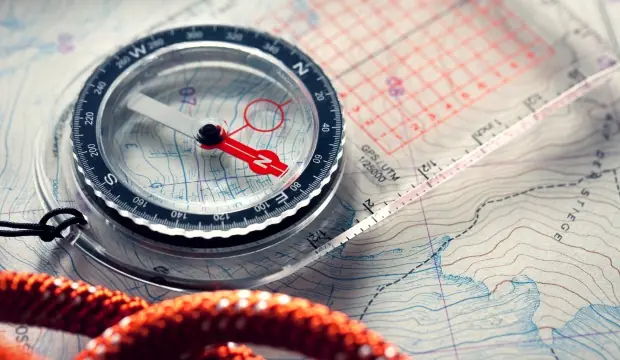
When hiking deep into the wilderness—especially when venturing off trail—there's no substitute for a compass and a detailed topographic map.
Sure, cell phone apps and GPS tools make navigation simple and less cumbersome, but their reliance on batteries and satellite signals to guide you on your adventure also make them less dependable. But putting your safety in the hands of batteries and signals from outer space is not a risk worth taking.
A compass and a map may seem old-fashioned to the modern-day hiker. However, the ability to orient yourself and pinpoint your exact location on a topographic map could save your life.
What Type of Compass Should I Buy?
The most important thing to consider when buying a compass is just that: to buy a compass.
Becoming disoriented is one of the most dangerous and fear-inducing experiences a hiker can face. Any compass that accurately displays magnetic north is a life-saving instrument.
With your compass being your guiding hand, you want it to be as accurate and reliable as possible. For instance, you likely wouldn't take your keychain compass on a five-day hike through the Sierra Nevada.
Here are three things to consider before buying a compass:
1. Beware of Inaccurate and Cheap Compasses
It's important to be leery of cheap components that compromise the compass' reliability. There are many great, dependable pocket compasses, but there are also many cheap, plastic children's toys.
When making your purchase, you must distinguish between the two.
Remember, your compass needs to be sturdy, large enough to read, and marked with all 360 degrees.
2. Avoid Compasses Without Fluid-Filled Housings
Make sure the magnetic instrument of the compass is within a fluid-filled housing. In other words, the needle must be in a transparent liquid within the compass' circular face.
This fluid dampens the motion of the needle, making it possible to receive accurate readings without being perfectly still. It's best to avoid any compass without a fluid-filled housing.
3. Consider Your Needs as a Hiker or Orienteering Enthusiast
If you're a beginner, a simple pocket compass commonly used by Boy or Girl Scouts should do fine. In fact, the simpler and easier to decipher, the better for those new to finding their way through the wilderness.
If you're hiking through tough terrain and taking scenic routes, it's best to get an advanced baseplate compass. Baseplate compasses are more sophisticated and include a clear, plastic baseplate and a rotating dial. This makes finding and maintaining the direction you wish to travel more accurate.
If you're an orienteering or adventure racer, you'll need to consider buying a compass with the most needle stability.
While having a compass is an essential item for any hiker or outdoorsman, finding magnetic north will only get you so far. If you haven't already, learn to read and use a topographic map and a compass before your next outdoor adventure.
Related Articles:
 Book your next camping trip
Book your next camping trip


